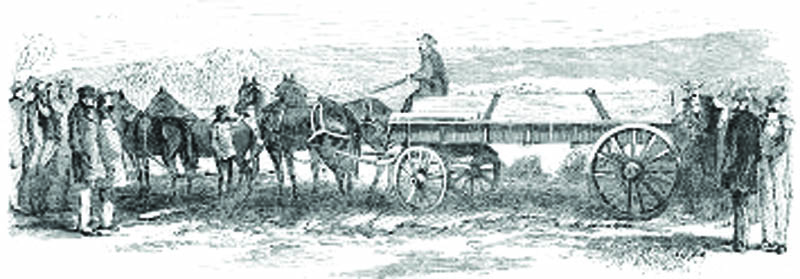There were giants on the earth
From the Mountains

Hundreds of curious individuals were traveling daily to see the wonder, over 10 feet tall, that was unearthed on Oct. 16, 1969.
White had doubts about the authenticity of the finding and was surprised with what he heard while visiting a respected church deacon and former county judge. “I’ll assure you this is no laughing matter,” White was told.
“It’s a very serious thing,” the deacon said. “There’s no doubt that an amazing discovery has been made. I hope you will go and see it for yourself. I am very interested in what you’ll think of it.”
The very next day, White and his brother sped along in a buggy on their way to Cardiff. The closer to their destination, the busier the trail became, all heading to the same destination.
There was a buzz, an excitement, in the air. Upon their arrival at the Newell farm, the site of the discovery, they found the scene to be reminiscent of a county fair, with a crowded tent with masses of people pressing to get inside. Where earlier the curious got to see the discovery without charge, farmer Stub Newell began charging 50 cents for admittance. None were turned away.
Everyone readily paid the fee to marvel at what was inside.
White noticed a earthy smell and a dug-out hole in the ground after entering the fairly large tent.
He positioned himself where he could see inside the hole, and when he did he saw the giant. It was huge, at least 10 feet long, just as he had heard from the stories bandied about.
It was about five or six feet below the surface, a stone giant with huge features, totally nude, its extremities bent in such a way as though it was in agony. It looked old, as though it had been in the Onondaga gray limestone for many years.
The stone there was known for its hardness, yet there were deep grooves in the underside of the giant that looked to be worn by water.
Many scientific minds concurred that it must have taken untold thousands of years to have that effect.
The scene seemed to command a sort of reverence, everyone spoke in hushed tones.
Ministers and theologians spoke of Genesis 6:4, citing, “There were giants on the Earth in those days,” making it easy for clergymen and Christians to give validity to the “petrified giant” found in New York.
They thought it was one of those giants who lived on the Earth in the days of the Bible, and talked about in the book of Genesis.
Others didn’t accept that idea, thinking instead that it was an ancient idol or statue.
Andrew White immediately thought chicanery was involved. Supposedly the giant was found while well drillers were searching for water, yet there was already a good source of water to the house and to the barn.
He wondered why they would have searched for water where the “giant” was discovered, that is, unless they were directed to search there so that it would be found. The topic of the petrified giant, or ancient statue, wouldn’t abate.
A week later, White was invited to return to Cardiff where he “noticed many men of light (knowledge and understanding) including an excellent doctor of divinity, other prominent clergymen and others who made pretensions to scientific knowledge.”
He was surprised that so many were swayed toward accepting the giant as authentic.
The exhibition proved to be very profitable.
Astute investors surmised that hugh profits could be made if it were acquired and displayed in metropolitan centers.
Many scientific minds were going on record calling the giant a hoax, so the owners decided it was a good time to take their money and run.
The giant was sold to several businessmen for $37,500, a large sum in 1869. They had the giant brought to the surface, loaded aboard a wagon and transported to Syracuse.
Once it went on exhibit in Syracuse, it received much attention, and ticket sales were brisk.
Othniel C. Marsh, a paleontologist from Yale University, examined the giant in Syracuse.
“I must admit the so-called giant is a fake,” Marsh stated. “It is a clumsy fake, at that. The chisel marks are plainly visible.
“The marks would have worn away if it been in the earth for an appreciable length of time. There’s no doubt it is a fake.”
The public seemed not to respond to Marsh’s rebuke as they continued flocking to see it.
P.T. Barnum, who was always interested in exhibiting the unusual and oddities of the world, offered the new owners $60,000 to lease the giant for three months.
They refused, but Barnum didn’t give up. He adopted an alternative plan to “cash in” on the giant.
Copyright 2023 Jadon Gibson.
Jadon Gibson is a freelance writer from Harrogate.
His writings are both historic and nostalgic in nature.
If you like his stories, tell others as they may like them, too.
Thanks to Lincoln Memorial University, Alice Lloyd College and the Museum of Appalachia. for their assistance.

